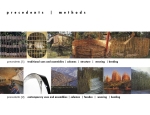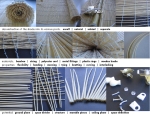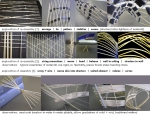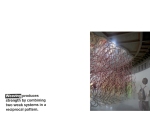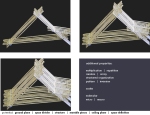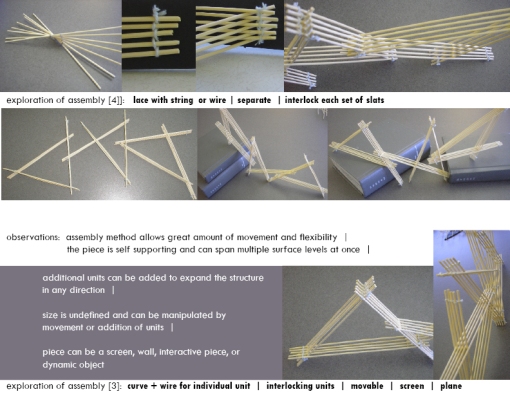9.9.10 reviews
We had our first “informally formal” review session yesterday, which generated a variety of interesting ideas, responses, and “what if” conversations.
Here is a link to my presentation slides of my process and ideas:
My process was an evolution of the following:
_what is the history and past usage of bamboo?
_what are its current uses?
_a study of connection methods and joint types
_deconstruction and study of the bamboo shade
_re-assembly [part 1]
_looking to nature for inspiration, much like Antoni Gaudi did
_re-assembly [part 2] “the loop,” adding to a chain or network of individual units
_re-assembly [part 3] “finger joint”
_multiplicity + pattern
_movement + interactivity
_practical applications – furniture, wall structure, storage, building skins…
_scale
Conclusions
My investigation did not lead to a specific conclusion or answer. Instead, it opened several possibilities depending on the scale of the material and the types of connections used, which I hope to explore further. The next step would require setting some parameters for continued development.
I want to zoom in on a detail, perhaps the assembly joint, and study its patterns, effects on movement, structural integrity, effects on light, repetition, then zoom back out to a larger scale and application. Another goal is to revisit the initial terms of the investigation. Do they still apply at the conclusion?
Some general questions raised by the review discussions:
_is this an additive or subtractive design process?
_how does the system or piece touch the ground?
_how do the material’s inherent strengths or qualities apply to real-life needs? what can be emphasized or played up?
_can you move up in scale with this material or do you need to study a new one also?
_are there metaphors or underlying symbolism in the material, the way it is used, or another application?
_how can a single material be both structure and skin? how is it used differently in each case?
Presentation Slides (in case the PDF doesn’t work…technology doesn’t always agree with me)

